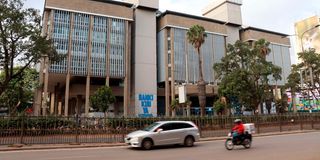New CBK leaders must engineer trust of lending risks to private borrowers

The Central Bank of Kenya, Nairobi. The next leadership of the Central Bank of Kenya (CBK) must ponder and wade through the assignment to sharpen deliverables, given the worsening economic conditions and a tradition of bank balance sheets tight-fisted with loans.
A concept called the Idiots Curve recently flashed on my LinkedIn pages. In summary, you will feel dumber before you get smarter on a new assignment, no matter how well-informed or experienced you are.
The next leadership of the Central Bank of Kenya (CBK) must ponder and wade through the assignment to sharpen deliverables, given the worsening economic conditions and a tradition of bank balance sheets tight-fisted with loans.
What a difference compared to 2015, when as acting chairman of the CBK Board, I started the shortlisting for the current leadership. We had a new Constitution and an amended CBK Act.
The outlook is more daunting than 2015. The IMF’s Global Stability Report paints a perilous picture after banks and businesses failed to prepare for this phase of rising interest rates. In low-income countries, excessive debt, high cost of failures to tackle fiscal, monetary and debt cracks, as well as a decline in demand for their exports are on the plate.
Listening to a House Committee chairperson fumble on subsidies to address hunger a week ago, I thought to prefix this piece with snapshots: Kenya’s failing policies compared to governments of quality we’ve had, such as the Mwai Kibaki era. The government teems with experts in metaphoric talk as the economy plummets to the edge of a debt default.
One prank by a Labour PS interprets his job as to roll out a bizarre economic fallacy: Educate Kenya’s skilled workers (at taxpayers’ expense – because Kenya boasts 86 per cent of the labour force with post-secondary education) and use more public money to migrate that labour to the Middle East.
We could cite many policies of shame but let’s stay with the topic of the day – rebuilding our macro-economic institutions and constructing a return to the growth path that Kibaki bequeathed Kenya.
Kenya’s growth potential still shines. US ambassador Meg Whitman summarised it brilliantly: Kenya leads as a regional hub for finance and logistics, and is the top destination for FDI. With the US as the lead export market, its economic conditions can be reshaped to improve our fortunes.
Among regulators in the financial sector, few match the capacity embedded in the CBK as I attested in my time, when we added to the CBK regulatory function of price stability, installing a matching board sub-committee. But challenges in CBK/fiscal policy interplay have intensified. We need to step things up.
Mismatched aims
Following the recent stock market rout, deposit flight from US and European banks – starting with Silicon Valley Bank – the failures brought tectonic shifts, placing central banks in a quandary on two mismatched aims: fighting stubbornly high inflation, while maintaining financial sector stability.
The reason recent collapses and systemic dangers were obvious in hindsight but unanticipated by policy makers is that central banks did not raise the alarm when regulatory floodgates were opened.
The repeal of the Dodd-Frank Act (thanks to the Donald Trump regime) played a part. After the 2008 crisis, the Act mended bank regulations for holdings of elevated shares in assets.
A high probability of global recession is predicted from the banking fallout. In the G7, the UK economy will contract by 0.3 per cent in 2023 forecasts.
Yet, while US banks failed trying to purr the American economy with corporate lending on the assets side, Kenya’s banks fail to support real economic potential by sticking to securities and keeping the rest of deposits mainly as liquidity, shunning the work of credit assessments. Banks, which by regulations should hold a minimum of 20 per cent liquidity ratio, sometimes have 88 per cent, piling up holdings in Treasury Bills and bonds – called fiscal dominance.
To promote growth and productivity, Kenya will have to venture into more complicated maths, drawing down liquidities and raising loan portfolios, for the following reasons.
First, as banks fight inflation with higher interest rates, dispensing with pandemic-era lower interest rates, it was inevitable that bonds and share prices would fall and yields rise, with pressure to control post-Covid era inflation as a priority. This drives instability in stocks and bonds markets. Unrealised losses have occurred, with banks teetering on insolvency.
Yet, relenting on interest rates as a trade-off to help lower bond yields and stave off the haemorrhage of “unrealised losses” in banks, associated with loan books, as well as values of stocks and bonds, has never looked more contradictory. Central banks like the FED and ECB insist on fixing inflation first.
Second, with the potentials cited above, banking for corresponding chances is thematically a private sector arena in which to grow Kenya’s socio-economic opportunities.
Yet, our banks tread on tiptoe to pin assets in the private sector, which holds back financial intermediation, economic activity and growth.
Third, in an emerging market, policy and National Treasury/CBK decisions – even when wrong – cut differently for investors and stakeholders.
Capital flows
While interest rates affect capital flows, increases or cuts affect domestic and foreign players differently. With increases, our business investors and households’ access to credit retreats.
Capital flows in contrast increase, especially portfolio flows, in search of interest margins. The reverse is the case when we lower interest rates and are faced with bouts of capital flight.
The macro-policy stance at present is an example of our dilemma. Rising interest rates and fiscal austerity run concurrently. This can only contract domestic investor opportunities with reduced access to credit to grow out of the slump, while external capital benefits.
Indeed, the purchasing managers price index, trending below 50 per cent shows contracting activity in manufacturing, retail, agriculture, services and construction. Austerity, deflation and economic contraction are associated with this erroneous policy mix.
In the contest between the two central banking objectives cited, Treasury spending and adjustments mainly drive the aggregate supply in targeted areas of the economy but can spill inflation and macro-instability.
The sluggish CBK monetary policy influences access to credit through interest rates but cannot influence supply. CBK modulates aggregated demand to align it with supply, using instruments to address overheating when spending or monetary excesses spill into inflation – targeted at the 2.5 to 7.5 per cent band.
The recent banking crisis exposed Kenya’s lending weakness in the private sector as if it was a virtue, mainly because “unrealised” losses were relatively low.
Paradoxically, muted losses were incurred by banks already enjoying comfortable margins, compared to major banks in US and Europe. In the latter zones, exemplified by SVB, banks piled their large cash deposits to Treasury bonds, long-dated private sector debt and related wealth assets on the assets side of their balance sheets. These operations generate strong corporate lending and securities.
Kenyan banks, however, keep a tradition on the liabilities side of their balance sheets (mostly customer deposits), translating them into a risk-averse mode – mainly treasury bills, bonds and only muted private sector lending on the assets side.
Portfolio hedges
A variety of portfolio hedges are used – lending and repayments in forex or minimising “unrealised” losses from securities by segmenting holdings into a tradable segment (marked to market), a segment for sales to gain from market positions and a segment held to maturity. I focus the failure of credit in Kenya’s macro-economy because, if business cannot access it, growth is restrained.
Tighter credit subscribes to that restraint but pointedly contracts the economy when tightened together with fiscal contraction as is happening.
Even worse, our broken credit markets restrain short-term employment, recovery and productivity.
The new CBK leadership needs to align with Kenya’s domestic, regional and global opportunities, by engineering trust of lending risks to borrowers in the private sector.
In the Reserve Bank of India, the Wilful Defaulter Law lowers risks and strengthens confidence, with loan collection in favour of commercial banks.
CBK could also pioneer a position that banks holding assets above a certain level be subjected to special regulations – a quasi-Dodd-Frank Act.
General outcomes bear out some of the disconnects on the recent banking crisis’ impact. In the US, high commercial lending powers private sector as an engine of economic growth and policy management. Although the impact of deflated values of stocks and bonds spilled over into Kenya, there is a stark contrast in heightened “unrealised losses” in the US. SVB sold some of its investments on the assets side, clocking $1.8 billion losses.
US bank losses reached $620 billion, about 28 per cent of their total capital, but the banks’ exposure to other assets like the long-dated loan-book portfolios are higher.
Kenyan banks’ unrealised losses at end of 2022 were only about nine per cent of core capital. The US “loan-book” losses from the inverse rule on stocks and bond prices versus yields raised unrealised losses to $1.75 trillion, or 80 per cent of their capital.
Why the vast difference? Kenyan banks’ tepid exposure to private sector lending, vis-a-vis US exposure to loan books and domestic sovereign risks is part of the reason. The highest unrealised losses to hit a Kenyan Tier One bank showed a paper loss of Sh29.01 billion in 2022, compared with Sh7.09 billion in 2021.
This is linked to a strategy of raising exposure to holding sovereign debt instruments – TBs and bonds – while shunning asset holdings in the loan book. Kenyan shareholders need to ask questions on how the loss will be managed, given the shareholder dividend payout amounts to only Sh15 billion.
In sum, Kenya’s highly profitable banks escaped SVB-like fallout not by virtue, a conservative tradition of avoiding powering and enlarging private sector loan books. The CBK and Treasury have homework to do in strengthening their policy intents to referee the appropriate macro-framework for growth in accordance with our potentials over business cycles.
Dr Wagacha, an economist, is a former Central Bank of Kenya chairman and adviser of the presidency.
Send us your email on [email protected] for a free subscription to your favourite weekly magazine in a mobile-optimised digital format. The Weekly Review is also available for free to Nation e-paper subscribers.




